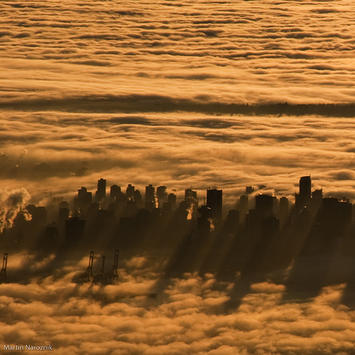
Is it density or migration? Venture capitalist Brad Feld weighs in:
The cities that have the most movement in and out of them are the most vibrant.
The densest city in the world won't be as vibrant as the city with the most talent churn. Yet planners and urbanists tout the former over the latter. We've reached the point of density for the sake of density. It is an end instead of a means to an end. The art of the density boondoggle:
The following is the conversation held at every regional summit on Long Island:
Advocate: Let’s keep our young people from leaving! There’s a…brain drain!
Public: How do we stop it?
Developer: Build denser housing! Let’s make it…affordable! Walkable! Let’s make it…mixed-use sustainable smart growth…with a downtown, pedestrian-friendly feel.
Municipality: Development approved!
What's the question? Greater density is the answer. It will plug the brain drain. I promise. But plugging the brain drain will reduce talent churn. Long Island will be less vibrant.
There is a name for the Cult of Density. It now has its very own -ism. All hail Vancouverism:
Vancouverism is, at the root, a movement to go from low density, to higher density, to make Canadian and North American cities about people once again.
Making cities all about people sounds great. All I hear is the chant of the Underpants Gnomes:
Phase 1: Create a cool city.
Phase 2: ?
Phase 3: Retain talent.That will be $500,000. Thank you for your patronage, Memphis. Consulting is fun!
Development approved. That's the story line playing out in downtown Las Vegas with Zappos. Density is king. Don't listen to Brad Feld. Talent churn doesn't matter.
If Vancouverism were harmless, then I wouldn't blog about it. The misplaced emphasis on density has negative impacts. Vancouver is more about people, those who are young, single and college-educated:
'Revitalizing,' but leaving seniors behind
Last July, Vancouver city council unanimously approved a three-year Chinatown Neighbourhood Plan and Economic Revitalization Strategy. More than a decade in the making, the plan focused on economic revitalization, after two-thirds of businesses surveyed in Vancouver's original Chinatown reported declining revenues between 2008 and 2011 -- blamed mainly on losses to newer Chinese-language communities in suburbs like Richmond.
The revitalization plan envisions new residential development, "to connect with younger generations and reach out to people of all backgrounds to ensure Chinatown is increasingly relevant to a more multi-cultural Vancouver." At the same time, it acknowledged that in a neighborhood where 67 per cent of households are low-income -- more than twice the City of Vancouver average -- such redevelopment "can displace low-income residents." What is good for old Chinatown's businesses, in short, may be less so for its poor and isolated elderly.
S.U.C.C.E.S.S., Vancouver's primary provider of culturally- and linguistically-supportive housing and services for Chinese seniors, is providing a partial answer. It operates a single multi-level care facility in old Chinatown for people with cognitive impairments or who require round-the-clock nursing. But its 103 beds, soon to be 113, are about one-tenth of what the UBC Centre for Urban Economics anticipates will be needed over the next 15 years to house Chinese seniors.
Meanwhile, the support it offers seem a world away from Rosesari and her neighbours living in privately operated SROs like the May Wah Hotel. Yet the women are spirited and resilient. "I'm happy and I'm healthy," Rosesari told me through Pang's interpretation. Both she and Lin say they like living in Chinatown. They feel at home here, where the language spoken is the one they know.
They are also in their 90s. As time goes on, they and others may no longer be able to manage the May Wah's staircases, its lack of mobility aids, and its communal bathing facilities. The alternatives available to them then are in terribly short supply.
Welcome to the dark side of the obsession with wants and needs of the Creative Class. Vancouverism is boutique urbanism, catering to a specific demographic at the exclusion of all others. People are either displaced or fall into the cracks. Bike lanes and food trucks trump the needs of seniors.
Jim Russell is a talent geographer with particular interest in the Rust Belt. Read his blog at Burgh Diaspora, where this piece originally appeared.
Downtown Vancouver photo by runningclouds












